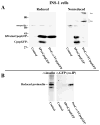Misfolded proinsulin in the endoplasmic reticulum during development of beta cell failure in diabetes
- PMID: 29377149
- PMCID: PMC5934315
- DOI: 10.1111/nyas.13531
Misfolded proinsulin in the endoplasmic reticulum during development of beta cell failure in diabetes
Abstract
The endoplasmic reticulum (ER) is broadly distributed throughout the cytoplasm of pancreatic beta cells, and this is where all proinsulin is initially made. Healthy beta cells can synthesize 6000 proinsulin molecules per second. Ordinarily, nascent proinsulin entering the ER rapidly folds via the formation of three evolutionarily conserved disulfide bonds (B7-A7, B19-A20, and A6-A11). A modest amount of proinsulin misfolding, including both intramolecular disulfide mispairing and intermolecular disulfide-linked protein complexes, is a natural by-product of proinsulin biosynthesis, as is the case for many proteins. The steady-state level of misfolded proinsulin-a potential ER stressor-is linked to (1) production rate, (2) ER environment, (3) presence or absence of naturally occurring (mutational) defects in proinsulin, and (4) clearance of misfolded proinsulin molecules. Accumulation of misfolded proinsulin beyond a certain threshold begins to interfere with the normal intracellular transport of bystander proinsulin, leading to diminished insulin production and hyperglycemia, as well as exacerbating ER stress. This is most obvious in mutant INS gene-induced Diabetes of Youth (MIDY; an autosomal dominant disease) but also likely to occur in type 2 diabetes owing to dysregulation in proinsulin synthesis, ER folding environment, or clearance.
Keywords: ER-associated degradation; Mutant INS gene-induced Diabetes of Youth; MIDY; disulfide mispairing; endoplasmic reticulum stress; ER; protein aggregation; secretory protein synthesis.
© 2018 New York Academy of Sciences.
Conflict of interest statement
The authors declare that we have no competing interests related to this work.
Figures







References
-
- Laybutt DR, Preston AM, Akerfeldt MC, et al. Endoplasmic reticulum stress contributes to beta cell apoptosis in type 2 diabetes. Diabetologia. 2007;50:752–763. - PubMed
-
- Eizirik DL, Cnop M. ER stress in pancreatic beta cells: the thin red line between adaptation and failure. Sci Signal. 2010;3:pe7. - PubMed
-
- Wang M, Kaufman RJ. Protein misfolding in the endoplasmic reticulum as a conduit to human disease. Nature. 2016;529:326–335. - PubMed
Publication types
MeSH terms
Substances
Grants and funding
LinkOut - more resources
Full Text Sources
Other Literature Sources
Medical

